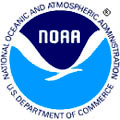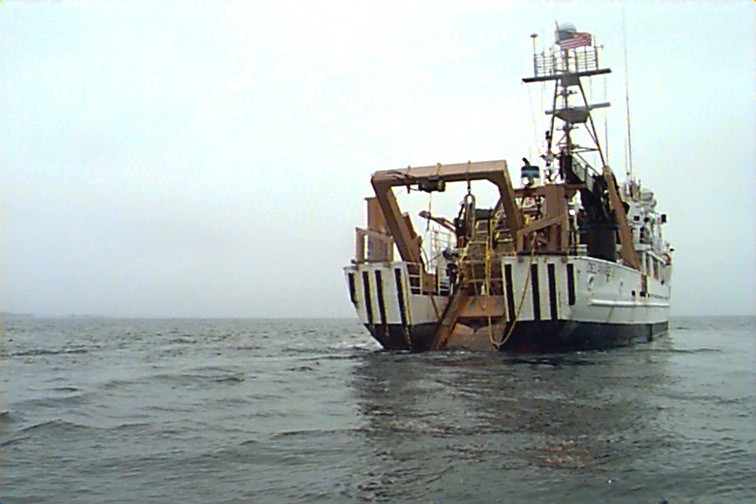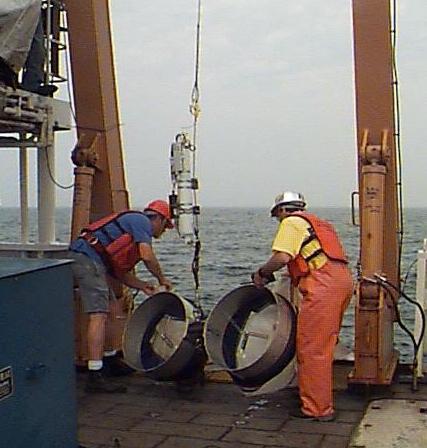US GLOBEC Transitions
 Mike Fogarty discussed the transfer of GLOBEC technology to an
operational setting within NOAA and other programs. NOAA-Fisheries has set up an eight node
cluster of linux computers. These machines have been used for forward
bio-physical modeling for sea scallops along the east coast and for data
assimilation using the Georges Bank mooring array (Schlitz and Smith). It is hoped that this
cluster can be used in a successful demonstration project to highlight the utility of
GLOBEC modeling capabilities in operational oceanography.
Mike Fogarty discussed the transfer of GLOBEC technology to an
operational setting within NOAA and other programs. NOAA-Fisheries has set up an eight node
cluster of linux computers. These machines have been used for forward
bio-physical modeling for sea scallops along the east coast and for data
assimilation using the Georges Bank mooring array (Schlitz and Smith). It is hoped that this
cluster can be used in a successful demonstration project to highlight the utility of
GLOBEC modeling capabilities in operational oceanography.
 NOAA-Fisheries currently conducts a number of surveys
from Cape Hatteras to
the Gulf of Maine each year. One potential question is how these surveys can
benefit from the high resolution sampling conducted on Georges Bank. Can the
survey designs be altered such that the main features observed in Georges Bank
GLOBEC are captured.
To this end, Georges Bank Broadscale data are being used to
examine the statistical properties of the estimates under different spatial
sampling regimes. The focus of this is to examine how changes in sampling
intensity influence abundance and distribution estimates. This project is also
using MARMAP and Ecosystem Monitoring data in a comparison with the Georges
Bank time series.
NOAA-Fisheries currently conducts a number of surveys
from Cape Hatteras to
the Gulf of Maine each year. One potential question is how these surveys can
benefit from the high resolution sampling conducted on Georges Bank. Can the
survey designs be altered such that the main features observed in Georges Bank
GLOBEC are captured.
To this end, Georges Bank Broadscale data are being used to
examine the statistical properties of the estimates under different spatial
sampling regimes. The focus of this is to examine how changes in sampling
intensity influence abundance and distribution estimates. This project is also
using MARMAP and Ecosystem Monitoring data in a comparison with the Georges
Bank time series.
Mike also discussed Coastal GOOS. US GLOBEC is very interested in interfacing
effectively with this program. Mike is a member of the Coastal GOOS panel and
will work to ensure this occurs.
 The Video Plankton Recorder has been very successful in US GLOBEC. Efforts are
underway to bring this technology into routine monitoring conducted by NOAA. A
short cruise is planned in the Gulf of Maine to compare VPR to Bongo sampling.
The bongo has a large sample volume, but provides no spatial resolution within a
tow. The
VPR provides excellent spatial resolution but has a very small sample volume.
It may therefore undersample rare taxa. If the effort is successful we may
develop a proposal to the Ocean Exploration Program to continue this work.
The Video Plankton Recorder has been very successful in US GLOBEC. Efforts are
underway to bring this technology into routine monitoring conducted by NOAA. A
short cruise is planned in the Gulf of Maine to compare VPR to Bongo sampling.
The bongo has a large sample volume, but provides no spatial resolution within a
tow. The
VPR provides excellent spatial resolution but has a very small sample volume.
It may therefore undersample rare taxa. If the effort is successful we may
develop a proposal to the Ocean Exploration Program to continue this work.
Cisco Werner suggested that another avenue may be to conduct a number of
OSSEs in Phase IV to examine the intensity and distribution of sampling required
to meet NOAA-Fisheries monitoring objectives.
Although many of the examples that Mike provided were derived from the
Georges Bank Program, which is entering its synthesis phase, it is hoped that we
can find even more applications for US GLOBEC technology in the other regional
programs.
 Mike Fogarty discussed the transfer of GLOBEC technology to an
operational setting within NOAA and other programs. NOAA-Fisheries has set up an eight node
cluster of linux computers. These machines have been used for forward
bio-physical modeling for sea scallops along the east coast and for data
assimilation using the Georges Bank mooring array (Schlitz and Smith). It is hoped that this
cluster can be used in a successful demonstration project to highlight the utility of
GLOBEC modeling capabilities in operational oceanography.
Mike Fogarty discussed the transfer of GLOBEC technology to an
operational setting within NOAA and other programs. NOAA-Fisheries has set up an eight node
cluster of linux computers. These machines have been used for forward
bio-physical modeling for sea scallops along the east coast and for data
assimilation using the Georges Bank mooring array (Schlitz and Smith). It is hoped that this
cluster can be used in a successful demonstration project to highlight the utility of
GLOBEC modeling capabilities in operational oceanography.  NOAA-Fisheries currently conducts a number of
NOAA-Fisheries currently conducts a number of  The Video Plankton Recorder has been very successful in US GLOBEC. Efforts are
underway to bring this technology into routine monitoring conducted by NOAA. A
short cruise is planned in the Gulf of Maine to compare VPR to Bongo sampling.
The bongo has a large sample volume, but provides no spatial resolution within a
tow. The
VPR provides excellent spatial resolution but has a very small sample volume.
It may therefore undersample rare taxa. If the effort is successful we may
develop a proposal to the Ocean Exploration Program to continue this work.
The Video Plankton Recorder has been very successful in US GLOBEC. Efforts are
underway to bring this technology into routine monitoring conducted by NOAA. A
short cruise is planned in the Gulf of Maine to compare VPR to Bongo sampling.
The bongo has a large sample volume, but provides no spatial resolution within a
tow. The
VPR provides excellent spatial resolution but has a very small sample volume.
It may therefore undersample rare taxa. If the effort is successful we may
develop a proposal to the Ocean Exploration Program to continue this work.